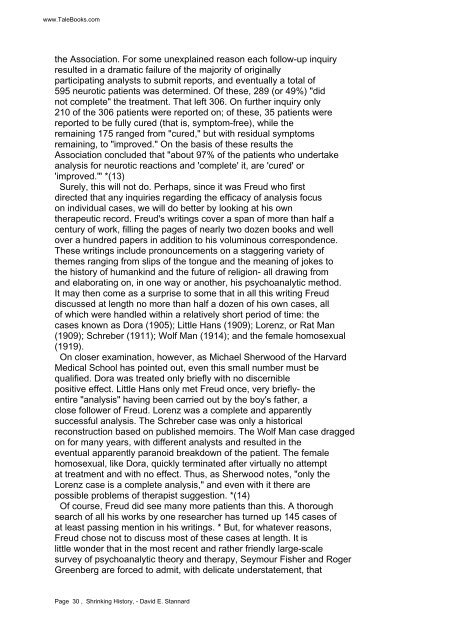SHRINKING HISTORY, On Freud and the Failure of ... - Planet.ee
SHRINKING HISTORY, On Freud and the Failure of ... - Planet.ee
SHRINKING HISTORY, On Freud and the Failure of ... - Planet.ee
Create successful ePaper yourself
Turn your PDF publications into a flip-book with our unique Google optimized e-Paper software.
www.TaleBooks.com<br />
<strong>the</strong> Association. For some unexplained reason each follow-up inquiry<br />
resulted in a dramatic failure <strong>of</strong> <strong>the</strong> majority <strong>of</strong> originally<br />
participating analysts to submit reports, <strong>and</strong> eventually a total <strong>of</strong><br />
595 neurotic patients was determined. Of <strong>the</strong>se, 289 (or 49%) "did<br />
not complete" <strong>the</strong> treatment. That left 306. <strong>On</strong> fur<strong>the</strong>r inquiry only<br />
210 <strong>of</strong> <strong>the</strong> 306 patients were reported on; <strong>of</strong> <strong>the</strong>se, 35 patients were<br />
reported to be fully cured (that is, symptom-fr<strong>ee</strong>), while <strong>the</strong><br />
remaining 175 ranged from "cured," but with residual symptoms<br />
remaining, to "improved." <strong>On</strong> <strong>the</strong> basis <strong>of</strong> <strong>the</strong>se results <strong>the</strong><br />
Association concluded that "about 97% <strong>of</strong> <strong>the</strong> patients who undertake<br />
analysis for neurotic reactions <strong>and</strong> 'complete' it, are 'cured' or<br />
'improved.'" *(13)<br />
Surely, this will not do. Perhaps, since it was <strong>Freud</strong> who first<br />
directed that any inquiries regarding <strong>the</strong> efficacy <strong>of</strong> analysis focus<br />
on individual cases, we will do better by looking at his own<br />
<strong>the</strong>rapeutic record. <strong>Freud</strong>'s writings cover a span <strong>of</strong> more than half a<br />
century <strong>of</strong> work, filling <strong>the</strong> pages <strong>of</strong> nearly two dozen books <strong>and</strong> well<br />
over a hundred papers in addition to his voluminous correspondence.<br />
These writings include pronouncements on a staggering variety <strong>of</strong><br />
<strong>the</strong>mes ranging from slips <strong>of</strong> <strong>the</strong> tongue <strong>and</strong> <strong>the</strong> meaning <strong>of</strong> jokes to<br />
<strong>the</strong> history <strong>of</strong> humankind <strong>and</strong> <strong>the</strong> future <strong>of</strong> religion- all drawing from<br />
<strong>and</strong> elaborating on, in one way or ano<strong>the</strong>r, his psychoanalytic method.<br />
It may <strong>the</strong>n come as a surprise to some that in all this writing <strong>Freud</strong><br />
discussed at length no more than half a dozen <strong>of</strong> his own cases, all<br />
<strong>of</strong> which were h<strong>and</strong>led within a relatively short period <strong>of</strong> time: <strong>the</strong><br />
cases known as Dora (1905); Little Hans (1909); Lorenz, or Rat Man<br />
(1909); Schreber (1911); Wolf Man (1914); <strong>and</strong> <strong>the</strong> female homosexual<br />
(1919).<br />
<strong>On</strong> closer examination, however, as Michael Sherwood <strong>of</strong> <strong>the</strong> Harvard<br />
Medical School has pointed out, even this small number must be<br />
qualified. Dora was treated only briefly with no discernible<br />
positive effect. Little Hans only met <strong>Freud</strong> once, very briefly- <strong>the</strong><br />
entire "analysis" having b<strong>ee</strong>n carried out by <strong>the</strong> boy's fa<strong>the</strong>r, a<br />
close follower <strong>of</strong> <strong>Freud</strong>. Lorenz was a complete <strong>and</strong> apparently<br />
successful analysis. The Schreber case was only a historical<br />
reconstruction based on published memoirs. The Wolf Man case dragged<br />
on for many years, with different analysts <strong>and</strong> resulted in <strong>the</strong><br />
eventual apparently paranoid breakdown <strong>of</strong> <strong>the</strong> patient. The female<br />
homosexual, like Dora, quickly terminated after virtually no attempt<br />
at treatment <strong>and</strong> with no effect. Thus, as Sherwood notes, "only <strong>the</strong><br />
Lorenz case is a complete analysis," <strong>and</strong> even with it <strong>the</strong>re are<br />
possible problems <strong>of</strong> <strong>the</strong>rapist suggestion. *(14)<br />
Of course, <strong>Freud</strong> did s<strong>ee</strong> many more patients than this. A thorough<br />
search <strong>of</strong> all his works by one researcher has turned up 145 cases <strong>of</strong><br />
at least passing mention in his writings. * But, for whatever reasons,<br />
<strong>Freud</strong> chose not to discuss most <strong>of</strong> <strong>the</strong>se cases at length. It is<br />
little wonder that in <strong>the</strong> most recent <strong>and</strong> ra<strong>the</strong>r friendly large-scale<br />
survey <strong>of</strong> psychoanalytic <strong>the</strong>ory <strong>and</strong> <strong>the</strong>rapy, Seymour Fisher <strong>and</strong> Roger<br />
Gr<strong>ee</strong>nberg are forced to admit, with delicate understatement, that<br />
Page 30 , Shrinking History, - David E. Stannard












